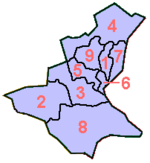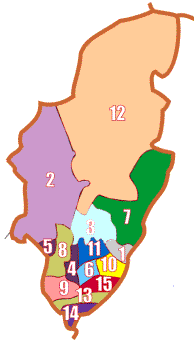
Centar, Sarajevo
Encyclopedia
Centar is a municipality
of central Sarajevo
in Bosnia and Herzegovina
. It is located between the older parts of the city under Stari Grad
, and the newer more modern parts of the city under the municipalities Novi Grad
and Novo Sarajevo
.
The Centar municipality, according to the government
website
, is the administrative, business
, commercial
, cultural
, education
al, and medical
centre of Sarajevo. Although some of these may be disputed, Centar is certainly the most important part of Sarajevo, housing most major branches of the city and national governments.
 The municipality of Centar occupies 3,313 hectrates of land, of which close to 17% is housing. The amount of private and state owned land is nearly equal, with 1600 and 1713 hectrates respectively. The municipality celebrates May 2 as "Centar Municipality Day", in commemoration of the heroic defense by citizens of the aggressor's assault on the Presidency Building
The municipality of Centar occupies 3,313 hectrates of land, of which close to 17% is housing. The amount of private and state owned land is nearly equal, with 1600 and 1713 hectrates respectively. The municipality celebrates May 2 as "Centar Municipality Day", in commemoration of the heroic defense by citizens of the aggressor's assault on the Presidency Building
of Bosnia and Herzegovina. Centar is also home to many Olympic
complexes such as City Hall Skenderija
and sports venues Kosevo Stadium and Olympic Hall Zetra
.
had a tremendous effect on Centar. Prior to the aggression, Centar municipality had 79,000 citizens, of which the majority were Bosniaks
. 7,000 citizens of the municipality were killed by the aggressors during the war, as major battles took place on its grounds. There was also a heavy presence of land mine
s in the area, however in December 2003 the government succeeded in clearing all land mines from the area. Since the end of the war, the municipality has received 12 major awards, indicating its current well-being and prosperity.
, 12% are Serbs
, 4% are Croats
and 2% are others.
 #Bardakčije
#Bardakčije
Municipality
A municipality is essentially an urban administrative division having corporate status and usually powers of self-government. It can also be used to mean the governing body of a municipality. A municipality is a general-purpose administrative subdivision, as opposed to a special-purpose district...
of central Sarajevo
Sarajevo
Sarajevo |Bosnia]], surrounded by the Dinaric Alps and situated along the Miljacka River in the heart of Southeastern Europe and the Balkans....
in Bosnia and Herzegovina
Bosnia and Herzegovina
Bosnia and Herzegovina , sometimes called Bosnia-Herzegovina or simply Bosnia, is a country in Southern Europe, on the Balkan Peninsula. Bordered by Croatia to the north, west and south, Serbia to the east, and Montenegro to the southeast, Bosnia and Herzegovina is almost landlocked, except for the...
. It is located between the older parts of the city under Stari Grad
Stari Grad, Sarajevo
Stari Grad is a municipality in Sarajevo, Bosnia and Herzegovina. It is the oldest and most historically significant part of Sarajevo...
, and the newer more modern parts of the city under the municipalities Novi Grad
Novi Grad, Sarajevo
Novi Grad is the westernmost of the four municipalities that make up the city of Sarajevo in Bosnia and Herzegovina.-History:...
and Novo Sarajevo
Novo Sarajevo
Novo Sarajevo is a municipality in Sarajevo, and Sarajevo Canton, Bosnia and Herzegovina.-1971:111,811 total* Serbs - 45,806 * Bosniaks - 37,147...
.
The Centar municipality, according to the government
Government
Government refers to the legislators, administrators, and arbitrators in the administrative bureaucracy who control a state at a given time, and to the system of government by which they are organized...
website
Website
A website, also written as Web site, web site, or simply site, is a collection of related web pages containing images, videos or other digital assets. A website is hosted on at least one web server, accessible via a network such as the Internet or a private local area network through an Internet...
, is the administrative, business
Business
A business is an organization engaged in the trade of goods, services, or both to consumers. Businesses are predominant in capitalist economies, where most of them are privately owned and administered to earn profit to increase the wealth of their owners. Businesses may also be not-for-profit...
, commercial
Commerce
While business refers to the value-creating activities of an organization for profit, commerce means the whole system of an economy that constitutes an environment for business. The system includes legal, economic, political, social, cultural, and technological systems that are in operation in any...
, cultural
Culture
Culture is a term that has many different inter-related meanings. For example, in 1952, Alfred Kroeber and Clyde Kluckhohn compiled a list of 164 definitions of "culture" in Culture: A Critical Review of Concepts and Definitions...
, education
Education
Education in its broadest, general sense is the means through which the aims and habits of a group of people lives on from one generation to the next. Generally, it occurs through any experience that has a formative effect on the way one thinks, feels, or acts...
al, and medical
Medicine
Medicine is the science and art of healing. It encompasses a variety of health care practices evolved to maintain and restore health by the prevention and treatment of illness....
centre of Sarajevo. Although some of these may be disputed, Centar is certainly the most important part of Sarajevo, housing most major branches of the city and national governments.

Presidency Building
The Presidency Building is the official residence of the Presidency of Bosnia and Herzegovina, located in the Centar Municipality of Sarajevo, in Bosnia and Herzegovina....
of Bosnia and Herzegovina. Centar is also home to many Olympic
Olympic Games
The Olympic Games is a major international event featuring summer and winter sports, in which thousands of athletes participate in a variety of competitions. The Olympic Games have come to be regarded as the world’s foremost sports competition where more than 200 nations participate...
complexes such as City Hall Skenderija
Skenderija
Skenderija is a city center in Sarajevo, Bosnia and Herzegovina. It was constructed in 1969 as a cultural and sport center, but was later revitalized and expanded for the 1984 Winter Olympic Games. Below the structure is a shopping mall...
and sports venues Kosevo Stadium and Olympic Hall Zetra
Olympic Hall Zetra
Olympic Hall Juan Antonio Samaranch , also known as Zetra Ice Stadium and Zetra Arena, is an indoor multi-purpose arena in Sarajevo, Bosnia and Herzegovina...
.
History
The Siege of SarajevoSiege of Sarajevo
The Siege of Sarajevo is the longest siege of a capital city in the history of modern warfare. Serb forces of the Republika Srpska and the Yugoslav People's Army besieged Sarajevo, the capital city of Bosnia and Herzegovina, from 5 April 1992 to 29 February 1996 during the Bosnian War.After Bosnia...
had a tremendous effect on Centar. Prior to the aggression, Centar municipality had 79,000 citizens, of which the majority were Bosniaks
Bosniaks
The Bosniaks or Bosniacs are a South Slavic ethnic group, living mainly in Bosnia and Herzegovina, with a smaller minority also present in other lands of the Balkan Peninsula especially in Serbia, Montenegro and Croatia...
. 7,000 citizens of the municipality were killed by the aggressors during the war, as major battles took place on its grounds. There was also a heavy presence of land mine
Land mine
A land mine is usually a weight-triggered explosive device which is intended to damage a target—either human or inanimate—by means of a blast and/or fragment impact....
s in the area, however in December 2003 the government succeeded in clearing all land mines from the area. Since the end of the war, the municipality has received 12 major awards, indicating its current well-being and prosperity.
1971
126.598 total- Muslims - 74.354 (58,73%)
- Serbs - 27.658 (21,84%)
- Croats - 12.903 (10,19%)
- Yugoslavs - 5.944 (4,69%)
- Others - 5.739 (4,55%)
1991
79.286 total- Muslims - 39.761 (50,14%)
- Serbs - 16.631 (20,97%)
- Croats - 5.428 (6,84%)
- Yugoslavs - 13.030 (16,43%)
- Others - 4.436 (5,62%)
Sarajevo (part of settlement), 1991. census
total: 76,771- Muslims by nationalityMuslims by nationalityMuslims by nationality was a term used in Socialist Federal Republic of Yugoslavia as an official designation of nationality of Slavic Muslims. They were one of the constitutive groups of Bosnia and Herzegovina...
- 38,860 (50.61%) - SerbsSerbsThe Serbs are a South Slavic ethnic group of the Balkans and southern Central Europe. Serbs are located mainly in Serbia, Montenegro and Bosnia and Herzegovina, and form a sizable minority in Croatia, the Republic of Macedonia and Slovenia. Likewise, Serbs are an officially recognized minority in...
- 15,192 (19.78%) - "YugoslavsYugoslavsYugoslavs is a national designation used by a minority of South Slavs across the countries of the former Yugoslavia and in the diaspora...
" - 12,958 (16.87%) - CroatsCroatsCroats are a South Slavic ethnic group mostly living in Croatia, Bosnia and Herzegovina and nearby countries. There are around 4 million Croats living inside Croatia and up to 4.5 million throughout the rest of the world. Responding to political, social and economic pressure, many Croats have...
- 5,415 (7.05%) - others and unknown - 4,346 (5.66%)
2002
According to government statistics from 2002, today Centar municipality has some 80 000 citizens, of which 82% are BosniaksBosniaks
The Bosniaks or Bosniacs are a South Slavic ethnic group, living mainly in Bosnia and Herzegovina, with a smaller minority also present in other lands of the Balkan Peninsula especially in Serbia, Montenegro and Croatia...
, 12% are Serbs
Serbs
The Serbs are a South Slavic ethnic group of the Balkans and southern Central Europe. Serbs are located mainly in Serbia, Montenegro and Bosnia and Herzegovina, and form a sizable minority in Croatia, the Republic of Macedonia and Slovenia. Likewise, Serbs are an officially recognized minority in...
, 4% are Croats
Croats
Croats are a South Slavic ethnic group mostly living in Croatia, Bosnia and Herzegovina and nearby countries. There are around 4 million Croats living inside Croatia and up to 4.5 million throughout the rest of the world. Responding to political, social and economic pressure, many Croats have...
and 2% are others.
Communities and neighborhoods

- Betanija - Šip
- Breka - Koševo II
- Ciglane - Gorica
- Donji Velešići
- Džidžikovac - Koševo I
- Hrastovi - Mrkovići
- Koševsko Brdo
- Marijin Dvor - Crni Vrh
- Mejtaš - Bjelave
- MZ Park - Višnjik
- Pionirska Dolina – Nahorevo
- Skenderija - Podtekija
- Soukbunar
- Trg Oslobođenja

